
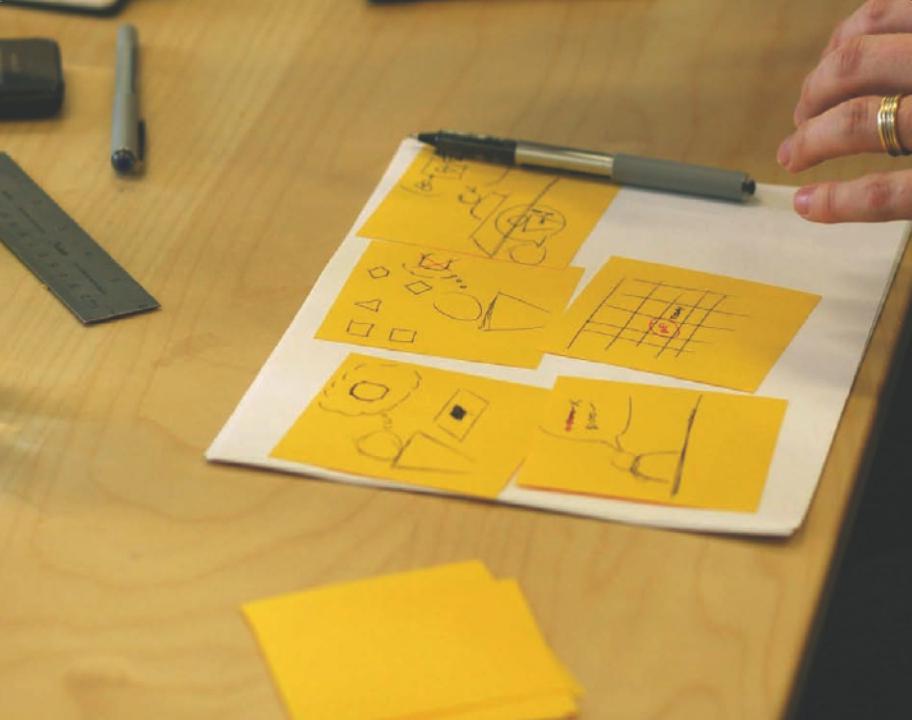
Technique_No. 6
Scenarios
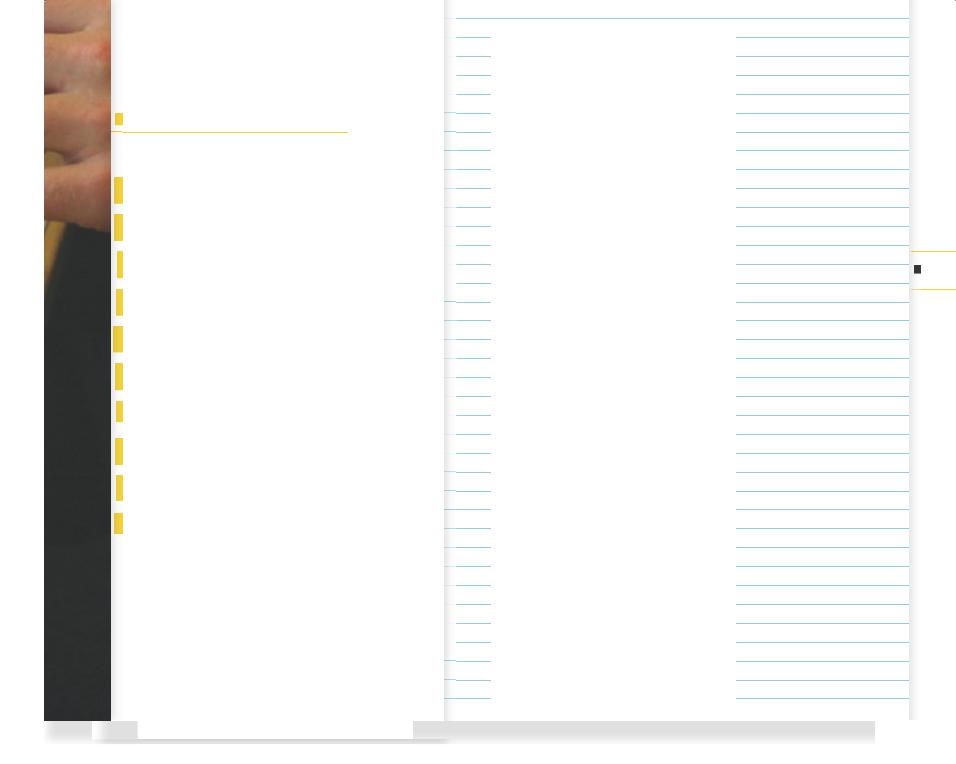
EBRUARY, 2000
Professor JeΩrey Huang and Muriel Waldvogel seem lost n thought as they ponder scale models of the Swisshouse, he new Swiss consulate facility
o be built in Boston, Massachusetts . . .
. . . Huang and Waldvogel were brought in to conceive the architectural design of the building, which, rather than issuing visas, will serve as a networking and knowledge exchange hub. The two are studying several scenarios of how people will use the Swisshouse, and have constructed both physical models and screenplay-like texts designed to make tangible the purpose of this unprecedented government facility.
One scenario describes Nicolas, a brain surgeon who has just moved to Boston from Switzerland. He visits the Swisshouse to meet likeminded scientists and other members of the Swiss-American community. A second scenario tells the story of a Professor Smith, who uses the Swisshouse to present his MIT Media Lab research to Boston’s Swiss community and to academics at two Swiss universities, using a high-speed Internet connection.
These scenarios, while simple, are the result of intensive research into roles the new type of consulate might play. The stories illustrate the Swiss government’s intentions and serve as thinking tools to guide the building’s design. Ultimately, the new facility effectively accommodated the applications imagined and fulfilled its objectives.
Today, almost a decade after its conception, the Swisshouse enjoys an outstanding reputation for helping build stronger international ties in greater Boston’s science and technology communities. Under the banner of the Swiss
Knowledge Network, or swissnex, the Swisshouse has inspired “colleague” facilities in Bangalore, San Francisco, Shanghai, and Singapore.
sCenarIos
81
desIgn

Scenario-Guided Business Model Design
—
Scenarios can be useful in guiding the design of new business models or innovating around existing models. Like visual thinking (p. 146), prototyping (p. 160), and storytelling (p. 170), scenarios render the abstract tangible. For our purposes, their primary function is to inform the business model development process by making the design context specific and detailed.
Here we discuss two types of scenarios. The first describes different customer settings: how products or services are used, what kinds of customers use them, or customer concerns, desires, and objectives. Such scenarios build on customer insights (p. 126), but go a step further by incorporating knowledge about customers into a set of distinct, concrete images. By describing a specific situation, a customer scenario makes customer insights tangible.
A second type of scenario describes future environments in which a business model might compete. The goal here is not to predict the future, but rather to imagine possible futures in concrete detail. This exercise helps innova-
tors reflect on the most appropriate business model for each of several future environ-
ments. The strategy literature discusses this practice in detail under the topic of “scenario planning.” Applying scenario planning techniques to business model innovation forces reflection on how a model might have to evolve under certain conditions. This sharpens understanding of the model, and of potentially necessary adaptations. Most important, it helps us prepare for the future.
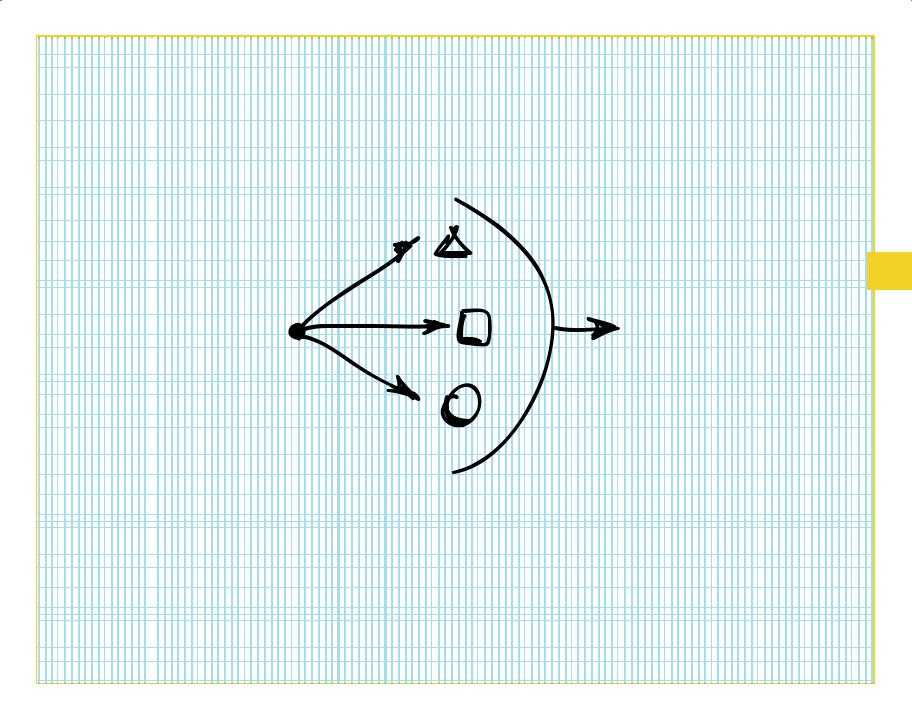
Directions
MAKE TANGIBLE
INFORMED
DESIGN
sCenarIos
183
desIgn
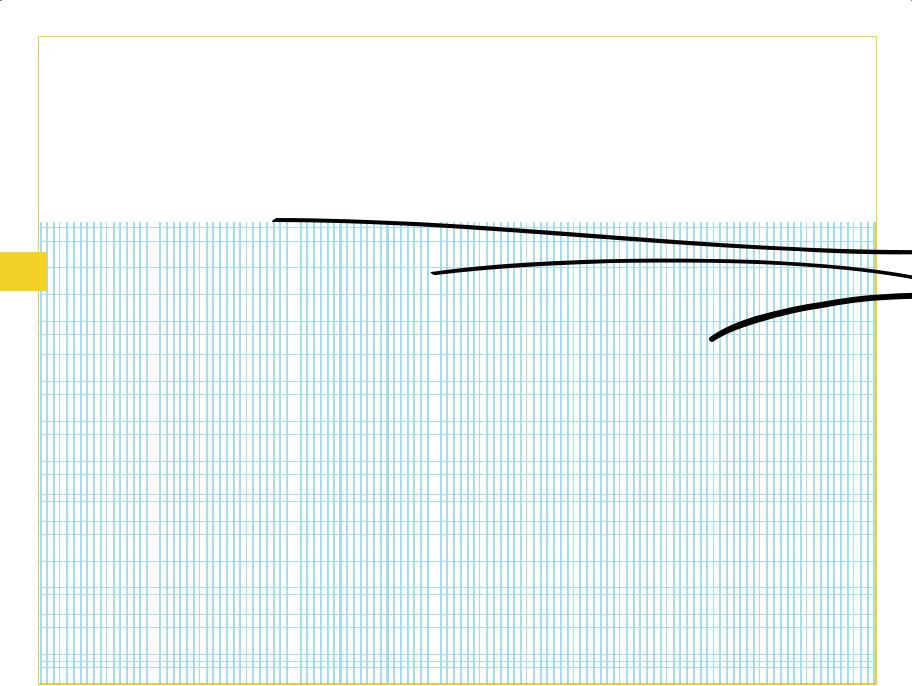

 Explore
Explore
 Ideas
Ideas



































































































sCenarIos
184184
desIgn
Customer scenarios guide us during business model design. They help us address issues such as which Channels are most appropriate, which relationships would be best to establish, and which problem solutions customers would be most willing to pay for. Once we’ve generated scenarios for different Customer Segments,
the home delivery service
Tom has always dreamed of running his own small ness. He knew it would be difficult, but earning a living by living his passion was definitely worth working more and earning less.
Tom is a film buff whose knowledge of movies is encyclopedic, and that’s what customers of his homedelivery DVD movie service appreciate. They can query him about actors, production techniques, and just about anything else film-related before ordering movies for delivery to their doorsteps.
Given the formidable online competition, it’s hardly an easy business. But Tom’s been able to boost his productivity and improve customer service with a new GPS-based delivery planner acquired from his mobile phone operator. For a small fee he equipped his phone with software that easily integrated with his Customer Relationship management program. This software won back much of Tom’s time by helping him better plan delivery routes and avoid traffic. It even integrated with the cell phones used by two aides who help out on weekends when demand for his service peaks. Tom knows his little business will never make him rich, but wouldn’t trade his situation for any corporate job.
we can ask ourselves whether a single business model is sufficient to serve them all—or if we need to adapt the model to each segment.
Here are three different scenarios describing loca- tion-based services that make use of Global Positioning Systems (GPS). They inform the business model design,
the tourists
Dale and Rose are traveling
weekend. They are excited because they haven’t visited Europe since their honeymoon 25 years ago. The couple organized this mini-escape from everyday work and family life just two weeks before departure, leaving their three kids with parents back in Portland. Lacking time and energy to plan the trip in detail, they decided to “wing it.” As a consequence, they were intrigued to read an article in the inflight magazine about a new GPSbased tourist service that uses mobile phones. Dale and Rose, both technology fans, rented the recommended handset upon arrival at Charles de Gaulle airport. Now they’re happily strolling around Paris on a customized tour proposed by the compact device—all without having consulted a single traditional tourist guide. They particularly appreciate the built-in audio guide that suggests various story and background information options as they approach particular sites. On the return flight, Dale and Rose muse about relocating to Paris after retiring. Laughing to themselves, they wonder whether the handy device would be enough to help them adapt to French culture.
but are deliberately left open to allow for specific questions around the Value Proposition, Distribution Channels, Customer Relationships, and Revenue Streams. The scenarios are written from the standpoint of a mobile telephone service operator working to develop innovative new business models.
the wine farmer
Alexander inherited vineyards from his father, who in turn inherited them from Alexander’s grandfather, who emigrated from Switzerland to California to grow wine. Carrying on this family history is hard work, but Alexander enjoys adding small innovations to his family’s long wine-growing tradition.
His latest discovery is a simple land management application that now resides on his mobile phone. Though not aimed at vintners, it was designed in such a way that Alexander was easily able to customize it for his own particular needs. The application integrates with his task list, which means he now has a GPS-based to-do list that reminds him when and where to check soil or grape quality. Now he’s pondering how to share the application with all of his managers. After all, the tool makes sense only if everyone on the management team updates the soil and grape quality database.
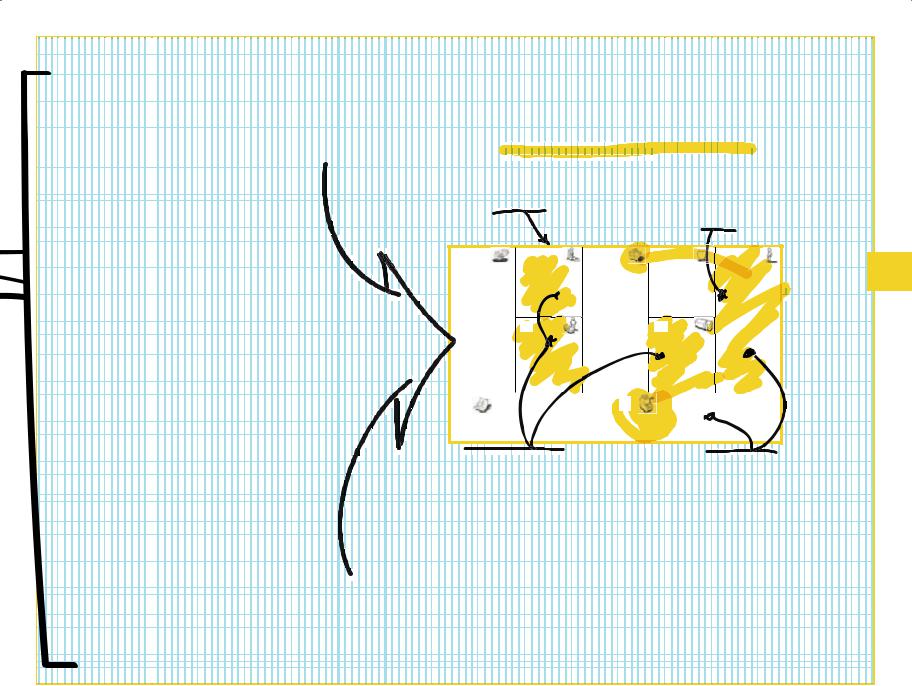
the tourists
•Should the service be based on a proprietary device or on an application that can be downloaded to customer handsets?
•Could airlines serve as Channel partners to distribute the service/device?
•Which prospective content partners would be interested in being part of the service?
•Which Value Propositions would customers be most willing to pay for?
the home delivery service
•Is the value added sufficient to motivate delivery services to pay monthly fees?
•Through which Channels could such Customer Segments most easily be reached?
•With what other devices and/or software would this service need to be integrated?
the wine farmer
•Is the value added sufficient to motivate a landowner to pay a monthly service fee?
•Through which Channels could such Customer Segments most easily be reached?
•With what other devices and/or software would this service need to be integrated?
questions regarding the business model
Could one model serve all |
Does each segment need |
three Customer Segments? |
a separate, specific Value |
|
Proposition? |
KP |
VP |
CR |
CS |
( |
|
|
|
|
KR |
|
|
|
|
CH |
|
|
|
|
|
|
|
|
|
C$ |
|
R$ |
|
||||
|
|
|
|
|
|
|
|
Could we create resource, activity, or Channel synergies by simultaneously serving all three Customer Segments?
Should we serve one or more Customer Segments at low or no cost in order to attract other, high-value customers?
sCenarIos
185
desIgn
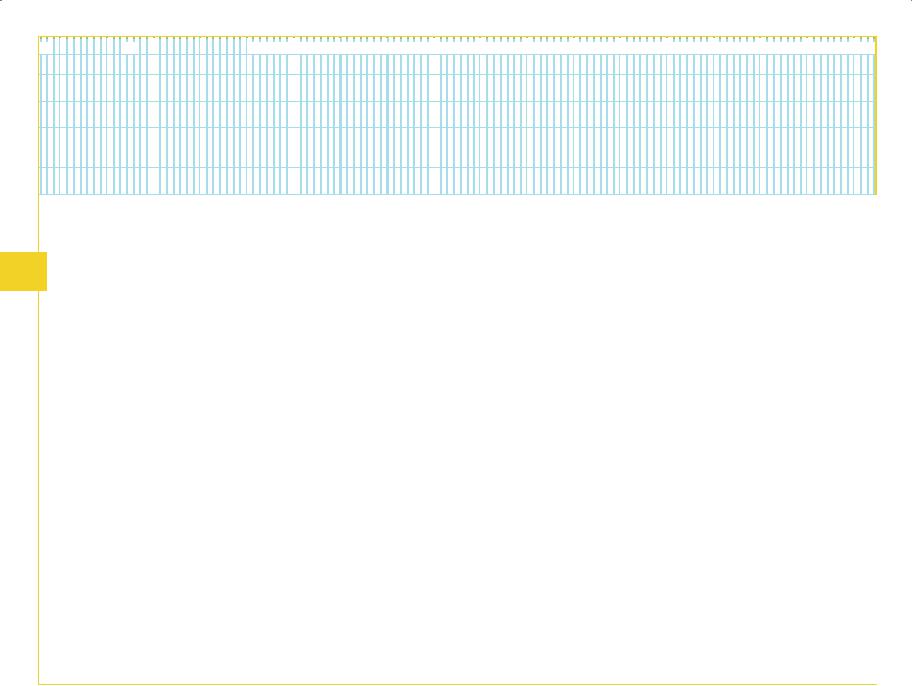

 Future
Future
 Scenarios
Scenarios





























































































sCenarIos
186186
desIgn
The scenario is another thinking tool that helps us reflect on business models of the future. Scenarios kick-start our creativity by providing concrete future contexts for which we can invent appropriate business models. This is usually easier and more productive than free brainstorming about possible future business models. It does require, however, developing several scenarios, which can be costly depending on their depth and realism.
One sector under strong pressure to devise innovative new business models is the pharmaceutical industry. There are a number of reasons for this. Major player research productivity has declined in recent years, and these companies face enormous challenges discovering and marketing new blockbuster drugs—traditionally the core of their businesses. At the same time, patents on many of their cash cow drugs are expiring. This means revenues from those drugs are likely to be lost to generic drug manufacturers. This combination of empty product pipelines and evaporating revenue are just two headaches plaguing incumbent pharmaceutical makers.
In this turbulent context, combining business model brainstorming with the development of a set of future
scenarios can be a powerful exercise. The scenarios help trigger out-of-the-box thinking, which is not always easy when trying to develop innovative business models. Here’s an overview of how such an exercise might be conducted.
First, we must devise a set of scenarios that paint pictures of the future of the pharmaceutical industry. This is best left to scenario planning specialists equipped with the right tools and methodology. To illustrate, we developed four bare bones scenarios based on two criteria that may shape the evolution of the pharma industry over the next decade. There are, of course, several other drivers and many different scenarios that could be crafted based on deeper research into the industry.
The two drivers we’ve selected are (1) the emergence of personalized medicine and (2) the shift from treatment toward prevention. The former is based on advances in pharmacogenomics, the science of identifying underlying causes of diseases based on a person’s DNA structure. Someday, this may result in completely personalized treatment, using customized drugs based on a person’s genetic structure. The shift from treatment to preven-
tion is driven in part by pharmacogenomics, in part by advances in diagnostics, and in part by renewed costconsciousness amid growing awareness that prevention is less expensive than hospitalization and treatment. These two drivers suggest trends that may or may not materialize and thus provide four scenarios illustrated in the figure opposite. These are:
•business as usual: Personal medicine fails to materialize despite its technological feasibility (e.g. for privacy reasons, etc.) and treatment remains the core revenue generator.
•my.medicine: Personal medicine materializes, but treatment remains the core revenue generator.
•the healthy patient: The shift toward preventive medicine continues, but personal medicine remains a fad despite technological feasibility.
•reinventing pharma: Personal and preventive medicine comprise the new growth areas of the drug industry.


 Pharma
Pharma
 Business
Business
 Models
Models




of the Future
C) The Healthy Patient:
•What kind of Customer Relationship does effective preventive medicine require?
•Who are the main partners we should involve in developing our business model for preventive medicine?
•What does the shift toward preventive medicine imply about the relationship between doctors and our salespeople?
personalized medicine remains a fad
prevention becomes the main revenue generator
A) Business as Usual
• How will our business model look in the future if these two drivers don’t change?
treatment remains the main revenune generator
D)Reinventing pharma:
•What does our Value Proposition look like in this new landscape?
•What roles will Customer Segments play under our new business model?
•Should we develop relevant activities, such as bioinformatics and gene sequencing, in-house or through partnerships?
personalized medicine becomes a market mainstay
B) My.medicine
•What kinds of relationships will we have to establish with patients?
•Which Distribution Channels are most appropriate for personalized medicine?
•Which resources and activities, such as bioinformatics and gene sequencing, do we need to develop?
sCenarIos
187
desIgn
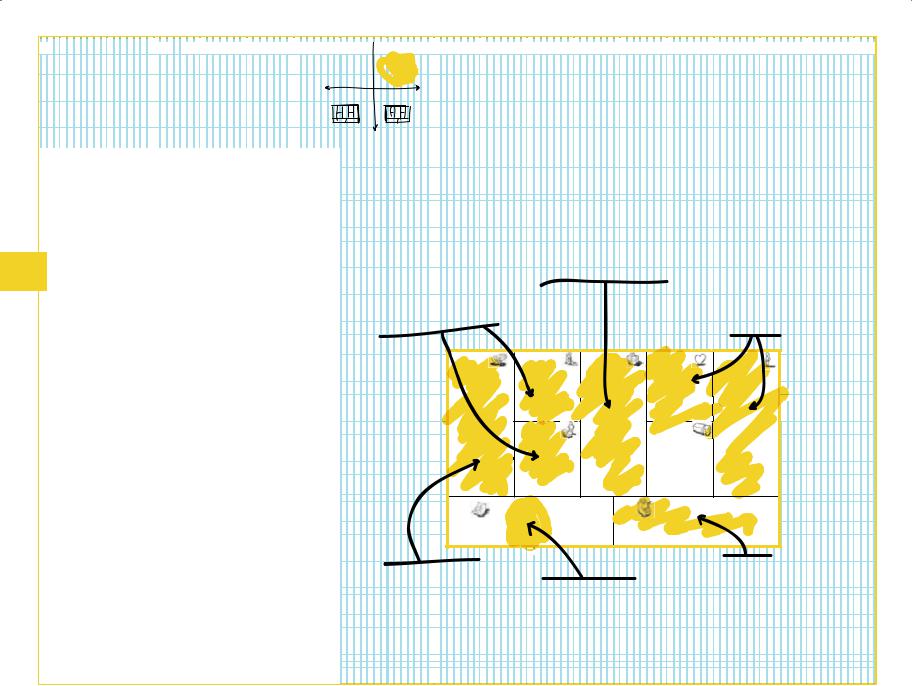

 Scenario
Scenario
 D:
D:
































































































Reinventing Pharma
sCenarIos
188188
desIgn
The landscape of the pharmaceutical industry has completely changed. Pharmacogenomic research has fulfilled its promise and is now a core part of the industry. Personalized drugs tailored to individual genetic profiles account for a large portion of industry revenues. All this has increased the importance of prevention—and is partially replacing treatment, thanks to substantially improved diagnostic tools and a better understanding of the links between diseases and individual genetic profiles.
These two trends—the rise of personalized drugs and the increasing importance of prevention—have completely transformed the traditional pharmaceutical manufacturing business model. The twin trends have had a dramatic impact on pharma’s Key Resources and Activities. They’ve transformed the way drug makers
approach customers and provoked substantial changes in how revenue is generated.
The new pharma landscape has taken a heavy toll on incumbents. A number were unable to adapt quickly enough and disappeared or were acquired by more agile players. At the same time, upstarts with innovative business models were able to acquire significant market share. Some were themselves acquired and integrated into the operations of larger but less nimble companies.
What new Key Resources and Key Activities will provide a competitive advantage when personalized drugs and prevention are the industry’s main focus?
What are the attributes of a competitive Value Proposition under the new landscape?
What roles will Customers and Customer Relationships play when personalized drugs are an industry mainstay?
CR |
CH
Which partnerships will maximize the effectiveness of a drug company’s new business model?
How will the Cost Structure of a pharmaceutical company’s business model change under this new landscape?
How will revenues be generated when the focus is on personalized drugs and prevention?

Future Scenarios and new
Business Models
1 |
2 |
3 workshop |
develop a set of future scenarios based |
describe each scenario with a story that |
develop one or more appropriate |
on two or more main criteria. |
outlines the main elements of the scenario |
business models for each scenario |
|
|
|
The goal of combining scenarios with business model innovation efforts is to help your organization prepare for the future. This process engenders meaningful discussion about a difficult topic, because it forces participants to project themselves into concrete “futures” underpinned by hard (though assumed) facts. When participants describe their business models they must be able to make a clear case for their choices within the context of the specific scenario.
Scenarios should be developed before the business model workshop begins. The sophistication of the “screenplays” will vary depending on your budget. Keep in mind that once you develop scenarios, they may be usable for other purposes as well. Even simple scenarios help jumpstart creativity and project participants into the future.
Ideally you should develop between two and four different scenarios based on two or more criteria in order to run a good business model scenario workshop. Each scenario should be titled and described with a short, specific narrative outlining the main elements.
Begin the workshop by asking participants to review the scenarios, then develop an appropriate business model for each. If your objective is to maximize a group’s understanding of all the potential futures, you might want everyone to participate in a single group and let them collectively develop different business models for each scenario. If you are more interested in generating a set of very diverse future business models, you might decide to organize participants into different groups that work in parallel on separate solutions for the various scenarios.
aCtIVIty
189189
desIgn
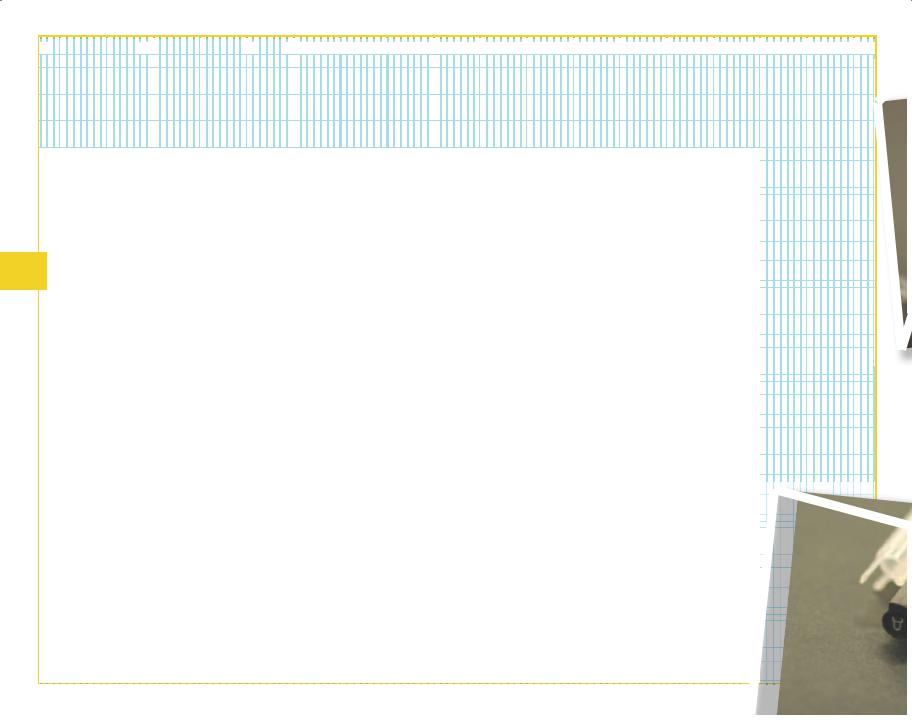

 Further
Further
 Reading
Reading
 on
on























































































 Design and Business
Design and Business
Further readIngs
190190
desIgn
Design Attitude |
Ideation |
Prototyping |
Managing as Designing |
The Art of Innovation: Lessons in Creativity |
Serious Play: How the World's Best |
by Richard Boland Jr. and Fred Collopy |
from IDEO, America's Leading Design Firm |
Companies Simulate to Innovate |
(Stanford Business Books, 2004) |
by Tom Kelley, Jonathan Littman, and |
by Michael Schrage (Harvard Business |
A Whole New Mind: Why Right-Brainers |
Tom Peters (Broadway Business, 2001) |
Press, 1999) |
Will Rule the Future |
IdeaSpotting: How to Find Your Next |
Designing Interactions |
by Daniel H. Pink (Riverhead Trade, 2006) |
Great Idea |
by Bill Moggridge (MIT Press, 2007) (ch. 10) |
The Ten Faces of Innovation: Strategies |
by Sam Harrison (How Books, 2006) |
|
for Heightening Creativity |
|
Storytelling |
by Tom Kelley (Profile Business, 2008) |
Visual Thinking |
The Leader's Guide to Storytelling: Mastering |
|
The Back of the Napkin: Solving Problems |
the Art and Discipline of Business Narrative |
Customer Insights |
and Selling Ideas with Pictures |
by Stephen Denning (Jossey-Bass, 2005) |
Sketching User Experiences: Getting |
by Dan Roam (Portfolio Hardcover, 2008) |
Made to Stick: Why Some Ideas Survive |
the Design Right and the Right Design |
Brain Rules: 12 Principles for Surviving |
and Others Die |
by Bill Buxton (Elsevier, 2007) |
and Thriving at Work, Home, and School |
by Chip Heath and Dan Heath |
Designing for the Digital Age: How to Create |
by John Medina (Pear Press, 2009) |
(Random House, 2007) |
Human-Centered Products and Services |
(pp. 221–240) |
|
by Kim Goodwin (John Wiley & Sons, Inc. 2009) |
|
Scenarios |
|
|
The Art of the Long View: Planning for |
|
|
the Future in an Uncertain World |
|
|
by Peter Schwartz (Currency Doubleday, 1996) |
|
|
Using Trends and Scenarios as Tools for |
|
|
Strategy Development |
|
|
by Ulf Pillkahn (Publicis Corporate |
|
|
Publishing, 2008) |
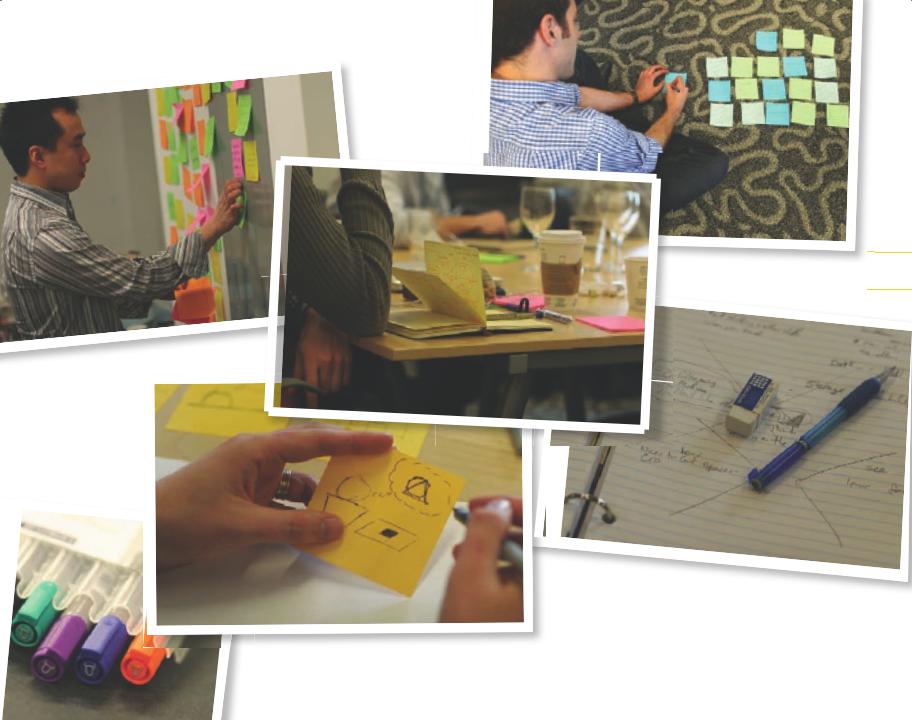
191

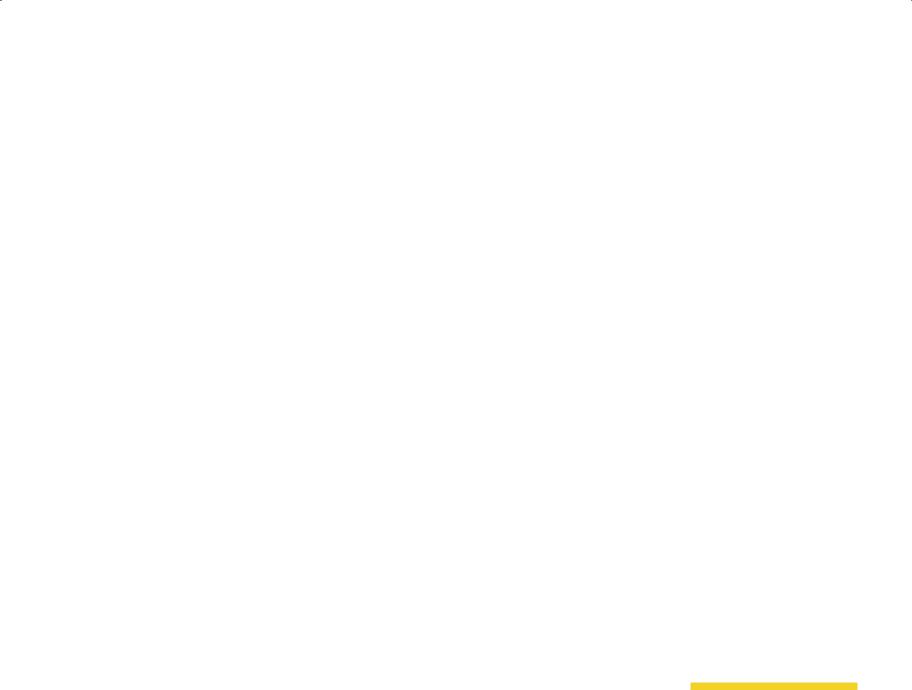
Do you have the guts to start from scratch?

WHAT
STAnDS
194 In YOUR
WAY?
In my work with non-profit organizations, the biggest obstacles to business model innovation are 1. inability
to understand the existing business model, 2. lack of a language to talk about business model innovation, and 3. counterproductive constraints on imagining the design of new business models.
Jeff De Cagna, United States
The management of an SME (wood manufacturing industry-WMI) did not begin changing its business model until the bank no longer wanted to give them credit. The biggest obstacle to business model innovation (in the WMI case and likely every case) is the people who resist any changes until problems appear and need corrective actions.
Danilo Tic, Slovenia
EvEryoNE
LovES
INNovAtIoN
uNtIL It AffEctS
thEm.
The biggest obstacle to business model innovation is not technology: it is we humans and the institutions
we live in. Both are stubbornly resistant to experimentation and change.
Saul Kaplan, United States
I have found that the management and key employees in many SME companies lack a common framework and language for discussing business
model innovation. They do not have the theoretical background, but they are essential to the process because they are the ones who know the business.
Michael N. Wilkens, Denmark
METRICS
OF SUCCESS:
They can direct the scope and ambition of behavior. At best they can allow
for the agility that brings truly disruptive innovation; at worst they reduce vision to near term iterative cycles of evolution that fail to take opportunity from changing environments.
Nicky Smyth, U.K.
Fear to take risks. As a CEO you need courage to take a business model innovation decision. In 2005, Dutch telecom provider KPn decided to migrate proactively to IP and thus to cannibalize its traditional business. KPn is now internationally recognized as an outperformer in the telco industry.
Kees Groeneveld, Netherlands
In my experience with a large archive, the biggest hurdle was to make them understand that even an archive has a business model. We overcame this by starting a small project and showed them this would affect their current model.
Harry Verwayen, Netherlands
GET EVERYBODY
inVolVed
and keep up the speed of change. For our disruptive meeting concept Seats-
2meet.com we trained the staff almost daily for a period of four months just on communicating this new business model to all stakeholders.
Ronald van Den Hoff, Netherlands
1. Organizational antibodies that attack a project as resources drawn from their area conflict with their business objectives. 2. Project management processes that can’t deal with risks/ uncertainties associated with bold ideas so leaders decline or claw ideas back to existing comfort zones.
John Sutherland, Canada
The biggest obstacle is a belief that models must contain every detail— experience shows that clients ask for a lot but settle for simplicity once they have insight into their business.
David Edwards, Canada

1. not knowing: What is a business model? What is business model innovation? 2. not able: How to innovate a business model? 3. not willing: Why should I innovate my business model?
Is there a sense of urgency?
4. Combinations of the above.
Ray Lai, Malaysia
In my experience, the biggest obstacle is failure to change the thinking process from the traditional linear way to holistic and systemic.
Entrepreneurs need to make a concerted effort to develop the capability to envision the model as a system whose parts interact with each other and affect each other in a holistic and non-linear manner.
Jeaninne Horowitz Gassol, Spain
As an Internet marketer for 15 years I’ve
seen new business models live and die.
The key for the winners was that the major stakeholders completely understood and advanced the model.
Stephanie Diamond, United States
THE MENTAL
MODELS
of executives and the board.
The lack of candor and fear of deviating from the status quo sets in groupthink.
Executives are comfortable with exploit phase and not ‘explore’ phase, which is unknown and hence risky.
Cheenu Srinivasan, Australia
In my experience as an Internet entrepreneur and investor, the biggest obstacles are lack of vision and bad governance. Without good vision and governance a company will miss the emerging industry paradigm and avoid reinventing the business model in time.
Within large multinationals it is key to create cross-functional understanding and synergies. Business model innovation does not hold itself to the organizational constraints that the people in
it experience. For successful execution it is key to have all disciplines on board and interconnected!
Bas van Oosterhout, Netherlands
FUG:
FEAr,
uNCErTAINTy
& grEED
of the people vested in the current business model. . .
Frontier Service Design, LLC, United States
A lack of entrepreneurship in the organization.
Innovation is about taking risks, wisely. If there is no room for creative insights or if people can’t think and act outside the boundaries of the existing model, don’t even try to innovate: you will fail.
On an organizational level, the biggest obstacle for a large, successful company is a reluctance to risk doing anything that may jeopardize their current model. On a leader/personal level, their very success was likely a product of the current business model...
Jeffrey Murphy, United States
“If it ain’t broke,
don't fix it”
thinking. Established companies stick to current ways of doing business until it is obvious that the customers want something else.
Ola Dagberg, Sweden
StrENGth
OF LEADERSHIP
can be an obstacle. Risk management and due diligence color the perceived purpose of many boards. Where innovation is assessed as a risk issue it's easy to relegate it to tokenism, especially within cultural institutions that tend
not to have championing cultures. Here innovation often dies the death of a thousand cuts inflicted by entrenched critical business processes, instead of being placed front and center as the fuel for future strategy.
Anne McCrossan, U.K.
Oftentimes, companies design an innovative business model, but do a poor job of constructing a compensation structure that is properly aligned with the model and its objectives.
Andrew Jenkins, Canada
CurrENT
SUCCESS
prevents companies from asking them-
selves how their business model could 195 be innovated. Organizational structures
are not typically designed for new business models to emerge.
Howard Brown, United States
The companies that are the most successful in continuously improving the efficiency of their current business
model often get blinded by
“this is the way things are done in our business"
and fail to see the emergence of innovative business models.
Wouter van der Burg, Netherlands
Nicolas De Santis, U.K. |
Ralf de Graaf, Netherlands |
|

Stra

tegy

“There’s not a single business model . . .
There are really a lot of opportunities and a lot of options and we just have to discover all of them.”
Tim O’Reilly, CEO, O’Reilly

In previous sections we taught you a language for describing, discussing, and designing business models, described business model patterns, and explained techniques that facilitate the design and invention of new business models. This next section is about re-interpreting strategy through the lens of the Business Model Canvas. This will help you constructively question established business models and strategically examine the environment in which your own business model functions.
The following pages explore four strategic areas: the Business Model Environment, Evaluating Business Models, a Business Model Perspective on Blue Ocean Strategies, and how to Manage Multiple Business Models within an enterprise.
Strategy
200Business Model Environment
212Evaluating Business Models
226Business Model  Perspective on Blue
Perspective on Blue
Ocean Strategy
232Managing Multiple Business Models

business model environment:
context, design drivers, and constraints
Business models are designed and executed in specific environments.
Developing a good understanding of your organization’s environment helps you conceive stronger, more competitive business models.
Continuous environmental scanning is more important than ever because of the growing complexity of the economic landscape (e.g. networked business models), greater uncertainty (e.g. technology innovations) and severe market disruptions (e.g. economic turmoil, disruptive new Value
200Propositions). Understanding changes in the environment helps you adapt your model more effectively to shifting external forces.
You may find it helpful to conceive of the external environment as a sort of “design space.” By this we mean thinking of it as a context in which to conceive or adapt your business model, taking into account a number of design drivers (e.g. new customer needs, new technologies, etc.) and design constraints (e.g. regulatory trends, dominant competitors, etc.). This
environment should in no way limit your creativity or predefine your business model. It should, however, influence your design choices and help you make more informed decisions. With a breakthrough business model, you may even become a shaper and transformer of this environment, and set new standards for your industry.
To get a better grasp on your business model “design space,” we suggest roughly mapping four main areas of your environment. These are (1) market forces, (2) industry forces, (3) key trends, and (4) macroeconomic forces. If you’d like to deepen your analysis of the landscape beyond the simple mapping we propose, each of these four areas is backed by a large body of literature and specific analytical tools.
In the following pages, we describe the key external forces that influence business models and categorize them using the four areas just mentioned. The pharmaceutical industry, introduced in the previous chapter, is used to illustrate each external force. The pharma sector is likely to undergo substantial transformation in coming years, though it is unclear how the changes will play out. Will biotechnology companies, which are currently copying the pharmaceutical sector’s blockbuster drug model, come up with new, disruptive business models? Will technological change lead to transformation? Will consumers and market demand force changes?
We strongly advocate mapping your own business model environment and reflecting on what trends mean for the future of your enterprise. A good understanding of the environment will allow you to better evaluate the different directions in which your business model might evolve. You may also want to consider creating scenarios of future business model environments (see p. 186). This can be a valuable tool for jumpstarting business model innovation work or simply preparing your organization for the future.
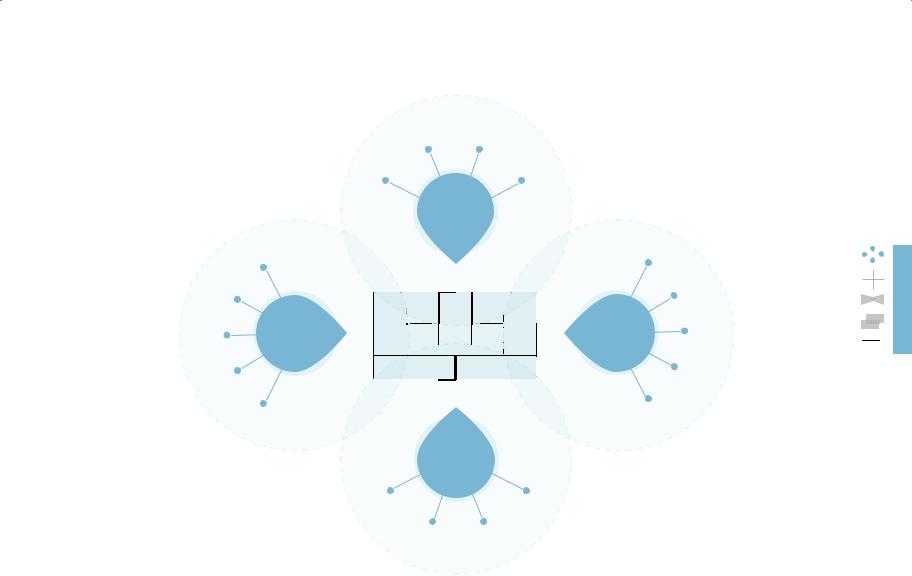
— competitive analysis —
—foresight —
ry trend |
societal an |
cultural trends |
technology |
|
end |
|
socioe |
|
conomic trends |
|
|
|||||
|
|
|
key trends
suppliers and other value |
market segments |
chain actors |
|
stakeholders |
KP |
KA |
VP |
CR |
CS |
competitors |
industry |
KR |
CH |
(incumbents) |
forces |
|
|
new entrants |
C$ |
R$ |
|
|
|
||
(insurgents) |
|
|
|
|
|
||
|
|
|
|
market |
needs an |
d demands |
|||
|
mark |
et issues |
|||
forces |
|
switch |
ing costs |
||
|
|
||||
substitute products |
revenue attractiveness |
and services |
|
macroeconomic forces
global market conditions |
economic infrastructure |
capital markets |
commodities and other resources |
— analysis market —
201
— macroeconomics —
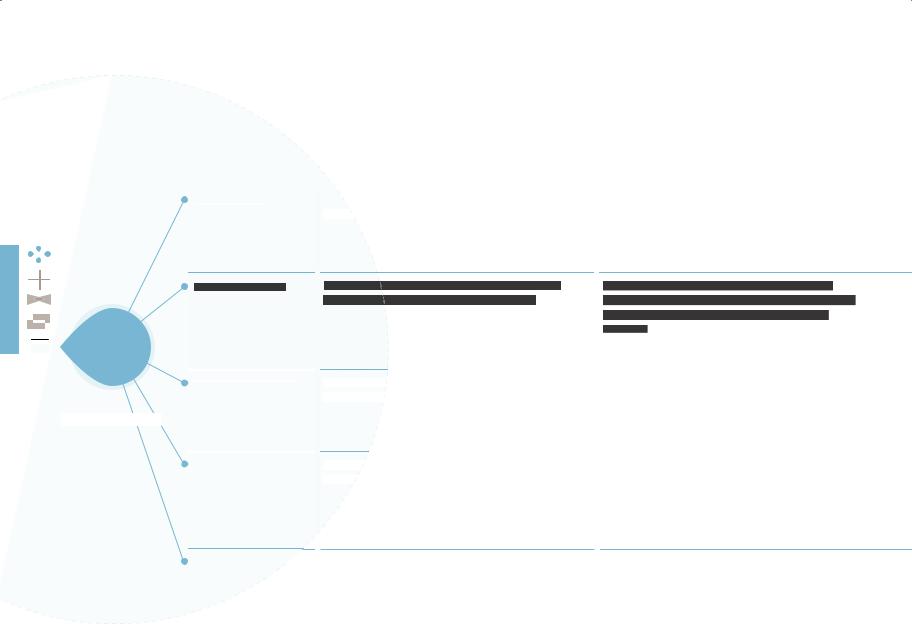
|
|
|
|
|
|
|
|
|
|
|
Main Qs |
|
|
|
|
|
market issues |
|
|
Identifies key issues driving and transforming your |
|
What are the crucial issues affecting the customer |
|
|
|
|
|
|
|
|
|
|
from Customer and Offer perspectives |
|
landscape? Which shifts are underway? Where is |
|
|
|
|
|
|
|
market |
|
|||
|
|
|
|
|
|
|
|
|
|
|
the market heading? |
|
|
|
|
|
|
|
|
|
|
|
|
|
|
|
|
|
|
|
|
|
|
|
|
|
|
|
|
|
|
|
|
|
|
|
|
|
|
|
|
|
|
|
|
|
|
|
|
|
|
market |
|
|
|
|
|
|
|
|
|
|
|
||||
202 |
|
forces |
|
|
|
|
|
|
|
|
|
|
|
||||
|
|
|
|
|
|
|
|
|
|
|
|
|
|||||
|
|
|
|
|
|
|
|
|
|
|
|
|
|
|
|
|
|
|
|
|
|
needs and demands |
|
|
|
|
|
|
|
|
|
needs and analyzes how well |
|
What do customers need? Where are the biggest |
|
|
|
|
|
|
|
|
Outlines market |
|
|
||||||||
|
|
|
|
|
|
|
|
|
|
|
|
|
|
|
|
|
unsatisfied customer needs? What do customers really |
|
|
|
|
|
|
|
|
|
they are served |
|
|
|
|||||
|
|
— market analysis — |
|
|
|
|
|
|
|
|
|
|
want to get done? Where is demand increasing? |
||||
|
|
|
|
|
|
|
|
|
|
|
|
Declining? |
|||||
|
|
|
|
|
|
|
|
|
|
|
|
|
|
|
|
|
|
|
|
|
|
|
|
|
|
|
|
|
|
|
|
|
|
|
|
|
|
|
|
switching costs |
|
|
|
|
|
|
elements related to customers switching |
|
What binds customers to a company and its offer? |
||||
|
|
|
|
|
|
Describes |
|
||||||||||
|
|
|
|
|
|
|
|
|
|
to competitors |
|
What switching costs prevent customers from defecting |
|||||
|
|
|
|
|
|
|
|
business |
|
||||||||
|
|
|
|
|
|
|
|
|
|
|
|
|
|
|
|
|
to competitors? Is it easy for customers to find |
|
|
|
|
|
|
|
|
|
|
|
|
|
|
|
|
|
and purchase similar offers? How important is brand? |
revenue |
Identifies elements related to revenue attractiveness |
What are customers really willing to pay for? Where can |
attractiveness |
and pricing power |
the largest margins be achieved? Can customers easily |
|
|
find and purchase cheaper products and services? |
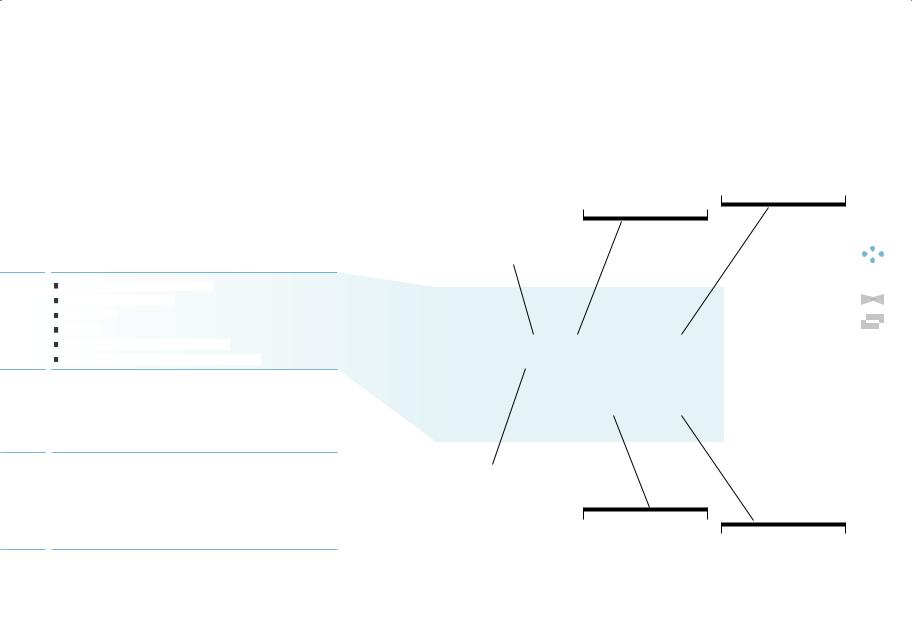
Pharmaceutical Industry Landscape
•Skyrocketing healthcare costs
•Emphasis shifting from treatment to prevention
•Treatments, diagnostics, devices, and support services are converging
•Emerging markets becoming more important
•

•

•

•

•

•

•Strong, with dispersed need for niche treatments
•Need to manage exploding cost of health care
•Large, unsatisfied health care needs in emerging markets and developing countries
•Consumers are better informed
•Monopoly on patent-protected drugs
•Low switching costs for patent-expired drugs replaceable by generic versions
•Growing amount of quality information available online
•Deals with governments, large-scale healthcare providers increase switching costs
•High margins on patent-protected drugs
•Low margins on generic drugs
•Healthcare providers, governments enjoy growing influence over prices
•Patients continue to have little influence over prices
what new key resources do we need to develop or acquire in light of the ongoing shift from treatment to prevention?
how can our value proposition address the issue of exploding health costs?
what would a greater focus on emerging markets mean for the other building blocks in our model?
|
|
|
|
|
|
|
|
|
|
|
|
|
|
|
|
|
|
|
|
|
|
|
|
|
|
|
|
|
|
|
|
|
|
|
|
|
|
|
|
|
|
|
|
|
|
|
|
|
|
|
|
|
|
|
|
|
|
|
|
|
|
|
|
|
|
|
|
|
|
|
|
|
|
|
KP |
KA |
VP |
|
CR |
CS |
|
|
|
|
|||||
|
|
|
|
|
|
|
|
|
|
|
|
|
|
|
|
|
|
|
|
|
|
|
|
|
|
|
|
|
|
|
|
|
|
|
|
|
|
|
|
|
||||
|
|
KR |
|
|
|
CH |
|
203 |
|
|
||||
|
|
|
|
|
|
|||||||||
|
|
|
|
|
|
|
|
|
|
|
|
|
|
|
C$ |
|
|
|
R$ |
|
|
|
|
|
|
|
|
||
|
|
|
|
|
|
|
|
|
|
|
|
|
|
|
|
|
|
|
|
|
|
|
|
|
|
|
|
|
|
|
|
|
|
|
|
|
|
|
|
|
|
|
|
|
what does the convergence of treatment, diagnostics, devices, and support services mean for our
key resources and activities?
how can we maintain earnings while addressing the public struggle to cope with skyrocketing healthcare costs?
what kind of new revenue opportunities might be created by the shift in emphasis from treatment to prevention?
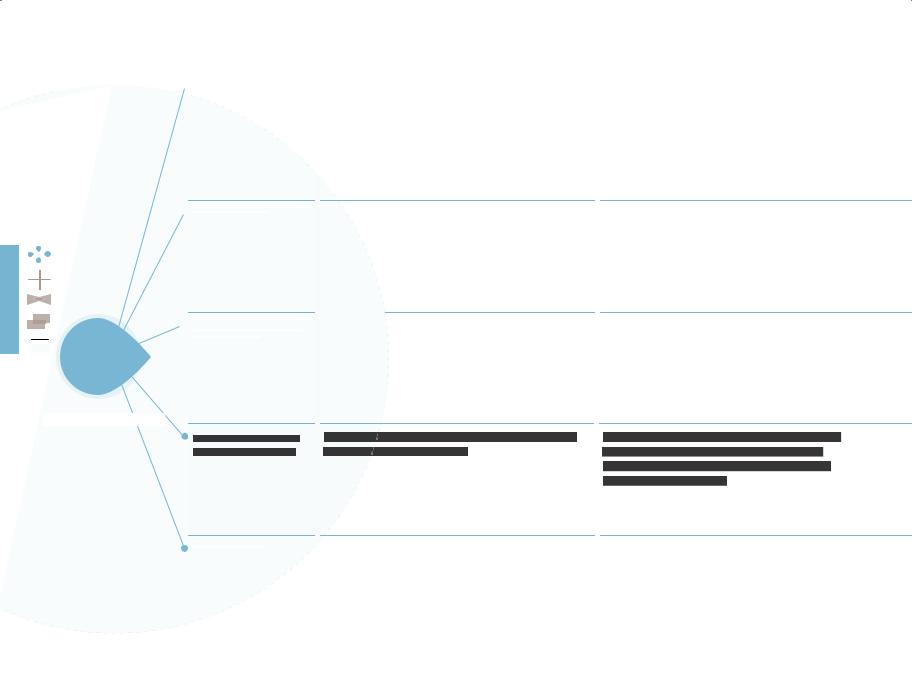














 competitors
competitors  (incumbents)
(incumbents)
 new entrants (insurgents)
new entrants (insurgents)
 substitute products
substitute products
and services
204 industry forces
— competitive analysis —
Identifies incumbent competitors and their relative strengths
Identifies new, insurgent players and determines whether
they compete with a business model different from yours
Describes potential substitutes for your offers—including
those from other markets and industries
stakeholders |
Specifies which actors may influence your organization |
|
and business model |
Main Qs
Who are our competitors? Who are the dominant players in our particular sector? What are their competitive advantages or disadvantages? Describe their main offers. Which Customer Segments are they focusing on? What is their Cost Structure? How much influence do they exert on our Customer Segments, Revenue Streams, and margins?
Who are the new entrants in your market? How are they different? What competitive advantages or
disadvantages do they have? Which barriers must they overcome? What are their Value Propositions? Which Customer Segments are they focused on? What is their Cost Structure? To what extent do they influence your Customer Segments, Revenue Streams, and margins?
Which products or services could replace ours? How much do they cost compared to ours? How easy it is for customers to switch to these substitutes? What business model traditions do these substitute products stem from (e.g. high-speed trains versus airplanes, mobile phones versus cameras, Skype versus long-distance telephone companies)?
Which stakeholders might influence your business model? How influential are shareholders? Workers? The government? Lobbyists?
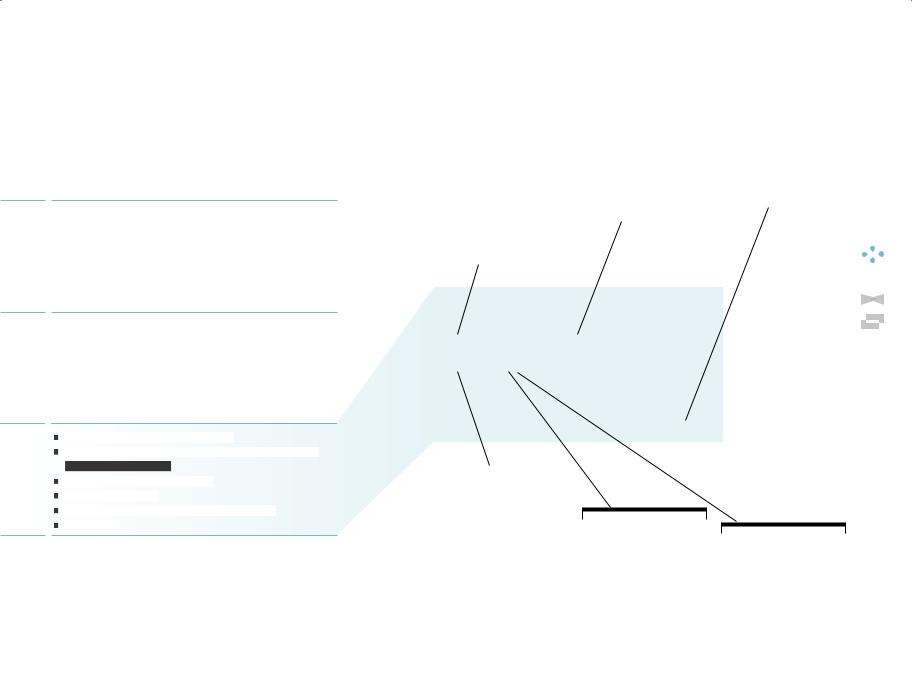
Pharmaceutical Industry Landscape
•Several large and medium size players compete in pharma
•Most players are struggling with empty product
pipelines and low R&D productivity
•Growing trend toward consolidation through mergers and acquisitions
•Major players acquire biotech, specialty drug developers to fill product pipeline
•Several players starting to build on open innovation processes
•Little disruption of the pharmaceutical industry over the last decade
•Main new entrants are generic drug companies, particularly from India
•To a certain extent, prevention represents a substitution
for treatment
• Patent-expired drugs replaced by low-cost generics
•

•

•

•

•

•

•Shareholder pressure forces drug companies to focus on short term (quarterly) financial results
•Governments/regulators have a strong stake in the actions of pharmaceutical companies because of their pivotal role in healthcare services
•Lobbyists, social enterprise groups and/or foundations, particularly those pursuing agendas such as low-cost treatments for developing countries
•Scientists, who represent the core talent of the drug manufacturing industry
for which parts of the industry value chain should key partnerships be built as opposed to developing key resources and activities in-house?
must the value |
|
which part of the |
proposition change to |
|
|
accommodate shifts in |
|
pharma industry |
the industry (e.g. the |
|
offers the greatest |
growing importance |
|
earnings potential? |
of biotech firms)? |
|
|
|
|
|
|
|
|
|
|
|
|
|
|
|
|
|
|
|
|
|
|
|
|
|
|
|
|
|
|
|
|
|
|
|
|
|
|
|
|
|
|
|
|
|
|
|
|
|
|
|
|
|
|
|
|
|
|
|
|
|
|
|
|
|
|
|
|
|
|
|
|
|
|
|
|
|
|
|
|
|
|
|
|
|
|
|
|
|
|
|
KP |
KA |
VP |
|
CR |
CS |
|
|
|
|
||||||
|
|
|
|
|
|
|
|
|
|
|
|
|
|
|
|
|
|
|
|
|
|
|
|
|
|
|
|
|
|
|
|
|
|
|
|
|
|
|
|
|
|
|
|
||||
|
|
KR |
|
|
|
CH |
|
205 |
|
|
|||||
|
|
|
|
|
|
||||||||||
|
|
|
|
|
|
|
|
|
|
|
|
|
|
|
|
C$ |
|
|
|
|
R$ |
|
|
|
|
|
|
|
|
||
|
|
|
|
|
|
|
|
|
|
|
|
|
|
|
|
|
|
|
|
|
|
|
|
|
|
|
|
|
|
|
|
|
|
|
|
|
|
|
|
|
|
|
|
|
|
|
|
could suppliers such as research contractors turn into competitors?
is it necessary to acquire smaller firms to fill product pipelines?
which of the key resources emerging among new actors in the value chain need to be developed in-house (e.g. bioinformatics)?
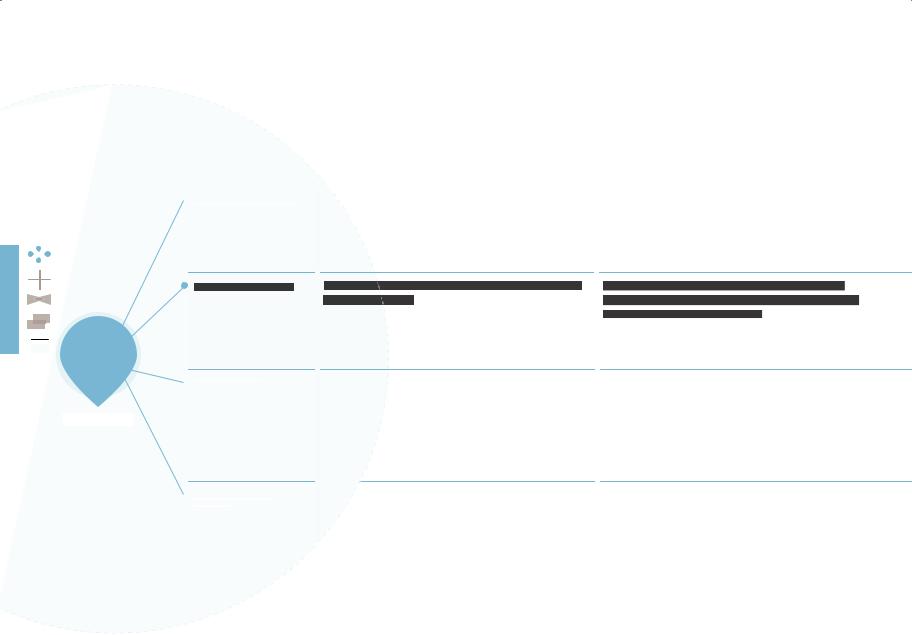
 technology trends
technology trends
206 key
trends
 societal and cultural trends
societal and cultural trends
— foresight —
 socioeconomic trends
socioeconomic trends
Identifies technology trends that could threaten your
business model—or enable it to evolve or improve
Identifies major societal trends that may influence your
business model
Outlines major socioeconomic trends relevant to your
business model
Main Qs
What are the major technology trends both inside and outside your market? Which technologies represent important opportunities or disruptive threats? Which emerging technologies are peripheral customers adopting?
Describe key societal trends. Which shifts in cultural or societal values affect your business model? Which trends might influence buyer behavior?
What are the key demographic trends? How would you characterize income and wealth distribution in your market? How high are disposable incomes? Describe spending patterns in your market (e.g. housing, healthcare, entertainment, etc.). What portion of the population lives in urban areas as opposed to rural settings?
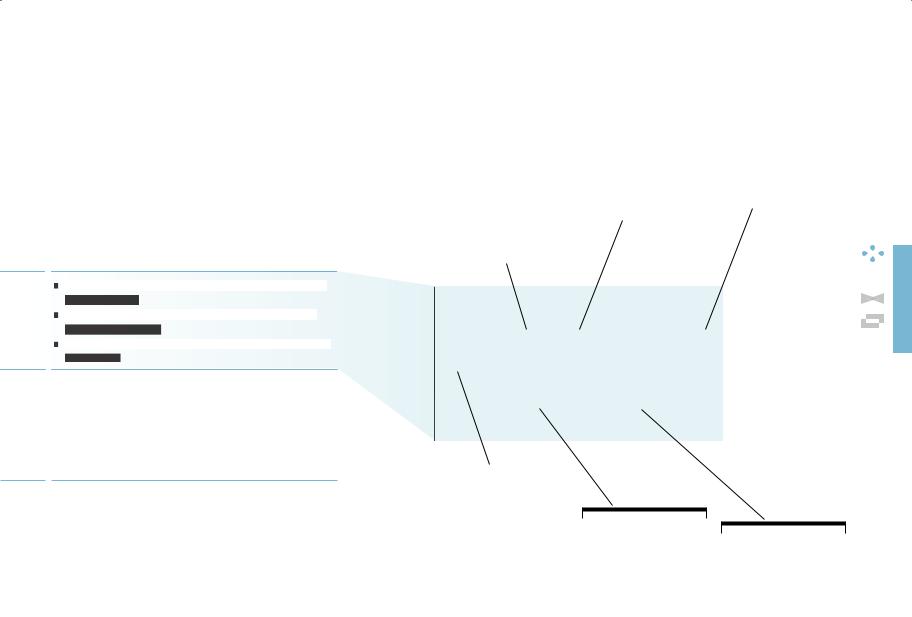
Pharmaceutical Industry Landscape
•Emergence of pharmacogenomics, declining cost of gene sequencing, and the immenent rise of personalized medicine
•Major advances in diagnostics
•Use of pervasive computing and nanotechnology for the injection/delivery of drugs
•

•

•

•Generally unfavorable image of big drug makers
•Growing social consciousness among consumers
•Customers increasingly conscious of global warming, sustainability issues, prefer “green” purchases
•Customers are better informed about drug maker activity in developing countries (e.g. HIV/AIDS drugs)
•Aging society in many mature markets
•Good but costly healthcare infrastructure in mature markets
•Growing middle class in emerging markets
•Large, unsatisfied healthcare needs in developing countries
|
|
which technologies |
|
how are customers |
|
|
are likely to improve |
|
reacting to new tech- |
which new key |
|
value proposition |
|
nological develop- |
resources and |
|
competitiveness in |
|
ments in the pharma- |
activities will prove |
|
the evolving pharma |
|
ceutical industry? |
advantageous when |
|
landscape? |
|
|
|
|
|
||
personalized drugs |
|
|
|
|
|
|
|
|
|
and diagnostics are |
|
|
|
|
widely used? |
|
|
|
|
|
|
|
|
|
|
|
|
|
|
|
|
|
|
|
|
|
|
|
|
|
|
|
|
|
|
|
|
|
|
|
|
|
|
|
|
KP |
KA |
VP |
|
CR |
CS |
|
|
|||||
|
|
|
|
|
|
|
|
|
|
|
|
|
|
|
|
|
|
|
|
|
|
|
|
|
|
|
|
|
|
|
|
|
|
|
||||
|
|
KR |
|
|
|
CH |
|
207 |
||||
|
|
|
|
|
|
|
|
|
|
|
|
|
C$ |
|
|
|
R$ |
|
|
|
|
|
|
||
|
|
|
|
|
|
|
|
|
|
|
|
|
|
|
|
|
|
|
|
|
|
|
|
|
|
|
|
|
|
|
|
|
|
|
|
|
|
|
which partnerships will become essential when pharmacogenomics is an integral part of the industry landscape?
how will technology such as pharmacogenomics, pervasive computing, and nanotechnology affect the cost structure of a drug maker’s business model?
do advances in pharmacogenomics, diagnostics, pervasive computing, or nanotechnology offer new revenue opportunities?
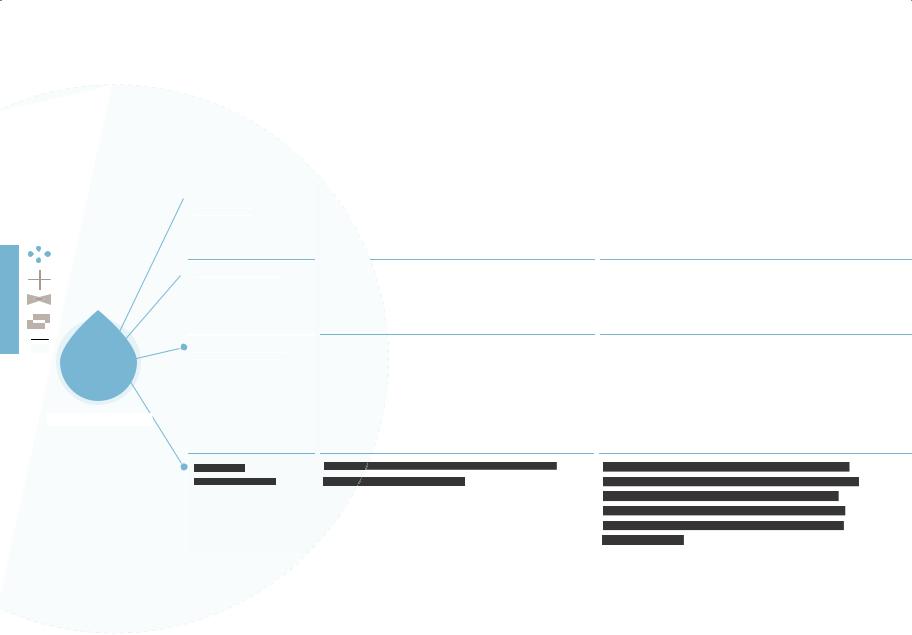
 global market conditions
global market conditions
 capital markets
capital markets
|
|
|
macro- |
|
|
|
|
|
commodities and |
|
|
208 |
|
||||
|
|
|
economic |
other resources |
|
|
|
|
forces |
|
|
|
|
— macroeconomics — |
|
|
|
|
|
|
|
|
|
Outlines current overall conditions from a macroeconomic perspective
Describes current capital market conditions as they
relate to your capital needs
Highlights current prices and price trends for resources
required for your business model
Main Qs
Is the economy in a boom or bust phase? Describe general market sentiment. What is the GDP growth rate? How high is the unemployment rate?
What is the state of the capital markets? How easy is it to obtain funding in your particular market? Is seed
capital, venture capital, public funding, market capital, or credit readily available? How costly is it to procure funds?
Describe the current status of markets for commodities and other resources essential to your business (e.g. oil prices and labor costs). How easy is it to obtain the resources needed to execute your business model (e.g. attract prime talent)? How costly are they? Where are prices headed?
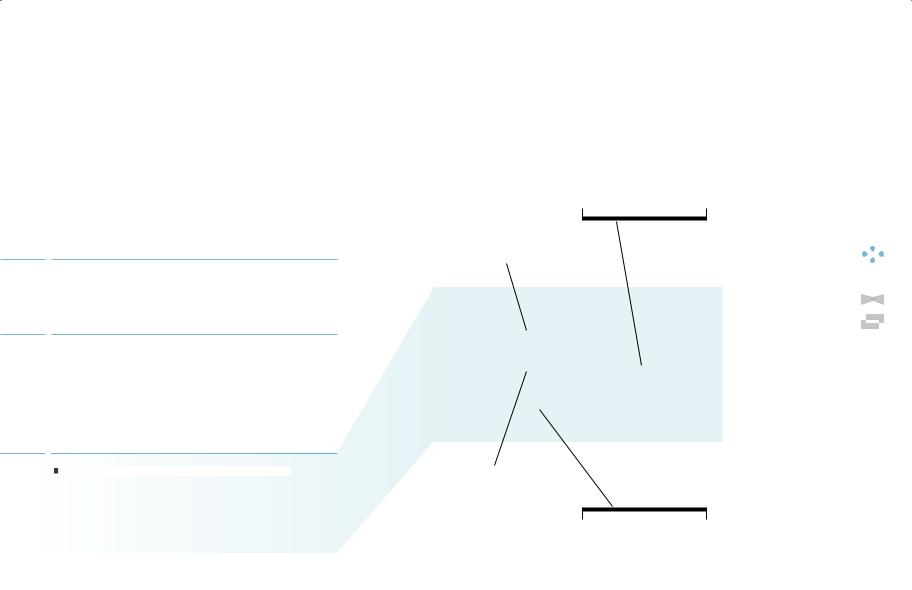
Pharmaceutical Industry Landscape
•Global recession
•Negative GDP growth in Europe, Japan, and the United States
•Slower growth rates in China and India
•Uncertainty as to when recovery will occur
•Tight capital markets
•Credit availability restricted due to banking crisis
•Little venture capital available
•Risk capital availability extremely limited
•Fierce “battles” for prime talent
•Employees seek to join pharmaceutical companies
with positive public image
•Commodity prices rising from recent lows
•Demand for natural resources likely to pick up with economic recovery
•Oil prices continue to fluctuate
•

does the economic infrastructure adequately support key activities?
does the infrastructure and trade environment adequately support channels?
|
|
|
|
|
|
|
|
|
|
|
|
|
|
|
|
|
|
|
|
|
|
|
|
|
|
|
|
|
|
|
|
|
|
|
|
|
|
|
|
|
|
|
|
|
|
|
|
|
|
|
|
|
|
|
|
|
|
|
|
|
|
|
|
|
|
|
|
|
|
|
|
|
|
|
KP |
KA |
VP |
|
CR |
CS |
|
|
|
|
|||||
|
|
|
|
|
|
|
|
|
|
|
|
|
|
|
|
|
|
|
|
|
|
|
|
|
|
|
|
|
|
|
|
|
|
|
|
|
|
|
|
|
||||
|
|
KR |
|
|
|
CH |
|
209 |
|
|
||||
|
|
|
|
|
|
|||||||||
|
|
|
|
|
|
|
|
|
|
|
|
|
|
|
C$ |
|
|
|
R$ |
|
|
|
|
|
|
|
|
||
|
|
|
|
|
|
|
|
|
|
|
|
|
|
|
|
|
|
|
|
|
|
|
|
|
|
|
|
|
|
|
|
|
|
|
|
|
|
|
|
|
|
|
|
|
do universities and other educational institutions furnish a sufficient amount of qualified talent?
how will local and national taxes affect the business model?
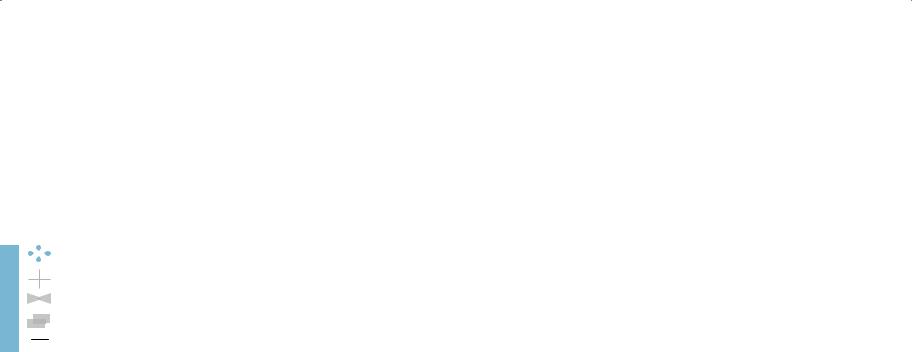
how should your business model evolve in light of a changing environment?
210
A competitive business model that makes sense in today’s environment might be outdated or even obsolete tomorrow. We all have to improve our understanding of a model’s environment and how it might evolve.
Of course we can’t be certain about the future, because of the complexities, uncertainties, and potential disruptions inherent in the evolving business environment. We can, however, develop a number of hypotheses about the future to serve as guidelines for designing tomorrow’s business models. Assumptions about how market forces, industry forces, key trends, and macroeconomic forces unfold give us the “design space” to develop potential business model options or prototypes (see p. 160) for the future. The role
of business model scenarios (see p. 186) in forecasting should also be evident by now. Painting pictures of the future makes it much easier to generate potential business models. Depending on your own criteria (e.g. acceptable level of risk, growth potential sought, etc.) you may then select one option over another.
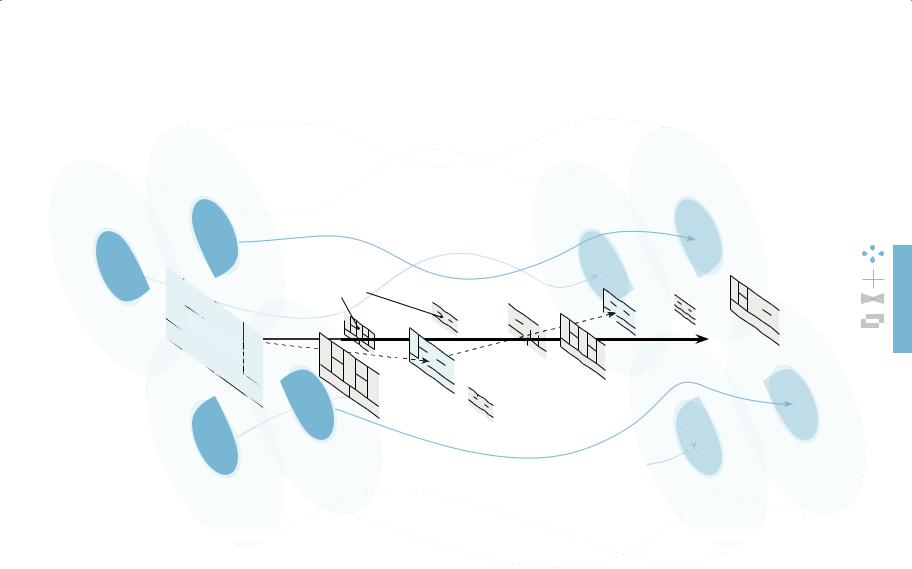
|
|
driving |
|
industry |
|
trends |
|
|
|
|
|
forces |
P |
|
Options |
|
|
||
|
KA |
|
|
|
|
VP |
|
|
|
CR |
|
|
C$ |
|
S |
|
|
|
|
|
|
R$ |
|
|
|
|
market |
|
|
macro- |
forces |
|
|
|
|
|
|
economic |
|
|
|
forces |
|
— present environment —
|
driving |
industry |
trends |
|
|
forces |
|
|
|
|
|
|
|
|
|
|
|
|
|
|
|
|
|
|
|
|
|
|
|
|
|
|
|
|
|
|
|
|
|
|
|
|
|
|
|
|
|
|
|
|
|
|
|
|
|
|
|
|
|
|
|
|
|
|
|
|
|
|
|
|
|
|
|
|
|
|
|
|
|
|
|
|
|
|
|
|
|
|
|
|
|
|
|
|
|
|
|
|
|
|
|
|
|
|
|
|
|
Time |
|
|
|
|
|
211 |
|||||||||||||||||
|
|
|
|
|
|
|
|
|
|
|
|
|
|
|
|
|
|
|
|
|
|
|
|
|
|
|
|
|
|
|
|||||||||||||||||||||||||||||||
|
|
|
|
|
|
|
|
|
|
|
|
|
|
|
|
|
|
|
|
|
|
|
|
|
|||||||||||||||||||||||||||||||||||||
|
|
|
|
|
|
|
|
|
|
|
|
|
|
|
|
|
|
|
|
|
|
|
|
|
|
|
|
|
|
|
|||||||||||||||||||||||||||||||
|
|
|
|
|
|
|
|
|
|
|
|
|
|
|
|
|
|
|
|
|
|
|
|
|
|
|
|
|
|
|
|
|
|
|
|
|
|
|
|
|
|
|
|
|
|
|
|
|
|
|
|
|
|
|
|
|
|
market |
|||
|
|
|
|
|
|
|
|
|
|
|
|
|
|
|
|
|
|
|
|
|
|
|
|
|
|
|
|
|
|
|
|
|
|
|
|
|
|
|
|
|
|
|
|
|
|
|
|
|
|
|
|
|
|
|
|
|
|
||||
|
|
|
|
|
|
|
|
|
|
|
|
|
|
|
|
|
|
|
|
|
|
|
|
|
|
|
|
|
|
|
|
|
|
|
|
|
|
|
|
|
|
|
|
|
|
|
|
|
|
|
|
|
|
|
|
|
|
||||
|
|
|
|
|
|
|
|
|
|
|
|
|
|
|
|
|
|
|
|
|
|
|
|
|
|
|
|
|
|
|
|
|
|
|
|
|
|
|
|
|
|
|
|
|
|
|
|
|
|
|
|
|
|
|
|
|
|
||||
|
|
|
|
|
|
|
|
|
|
|
|
|
|
|
|
|
|
|
|
|
|
|
|
|
|
|
|
|
|
|
|
|
|
|
|
|
|
|
|
|
|
|
|
|
|
|
|
|
|
|
|
|
|
|
|
|
|
||||
|
|
|
|
|
|
|
|
|
|
|
|
|
|
|
|
|
|
|
|
|
|
|
|
|
|
|
|
|
|
|
|
|
|
|
|
|
|
|
|
|
|
|
|
macro- |
|
|
|
|
forces |
||||||||||||
|
|
|
|
|
|
|
|
|
|
|
|
|
|
|
|
|
|
|
|
|
|
|
|
|
|
|
|
|
|
|
|
|
|
|
|
|
|
|
|
|
|
|
|
||||||||||||||||||
|
|
|
|
|
|
|
|
|
|
|
|
|
|
|
|
|
|
|
|
|
|
|
|
|
|
|
|
|
|
|
|
|
|
|
|
|
|
|
|
|
|
|
economic |
|
|
|
|
|
|
|
|||||||||||
|
|
|
|
|
|
|
|
|
|
|
|
|
|
|
|
|
|
|
|
|
|
|
|
|
|
|
|
|
|
|
|
|
|
|
|
|
|
|
|
|
|
|
|
|
|
|
|
|
|
|
|||||||||||
|
|
|
|
|
|
|
|
|
|
|
|
|
|
|
|
|
|
|
|
|
|
|
|
|
|
|
|
|
|
|
|
|
|
|
|
|
|
|
|
|
|
|
|
|
|
forces |
|
|
|
|
|
|
|
||||||||
— projected environment —
